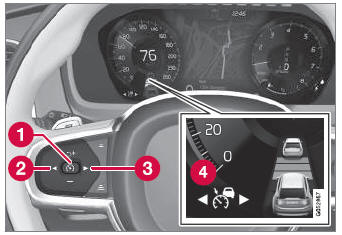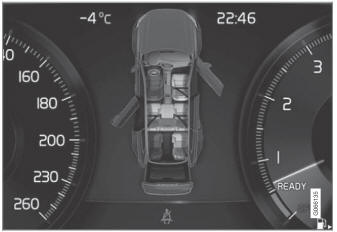Volvo XC90 2015-2025 Owners Manual / Driver support / Deactivating Adaptive Cruise Control
Volvo XC90: Driver support / Deactivating Adaptive Cruise Control
(Depending on market, this function can be either standard or optional.)
Adaptive Cruise Control (ACC2) can be deactivated and switched off.

- Press the
 button on the steering
wheel (1).
button on the steering
wheel (1).- The symbol and markings turn gray – Adaptive Cruise Control goes into standby mode. The time interval indicator light and any symbols for the target vehicle will go out.
- Press the
 (2) or
(2) or
 (3) buttons on the steering wheel
to select another function.
(3) buttons on the steering wheel
to select another function.- The Adaptive Cruise Control symbol and marking (4) in the instrument panel will go out and the stored maximum speed will be erased.
WARNING
- If Adaptive Cruise Control is in standby mode, the driver must intervene and regulate both speed and distance to the vehicle ahead.
- If the vehicle comes too close to a vehicle ahead when Adaptive Cruise Control is in standby mode, the driver can be warned of the short distance by the Distance Alert* function.
1 Adaptive Cruise Control
 Selecting and activating Adaptive Cruise Control
Selecting and activating Adaptive Cruise Control
(Depending on market, this function can be either standard or optional.)
Adaptive Cruise Control (ACC1 ) must first be selected and then
activated before it can regulate speed and distance...
 Adaptive Cruise Control standby mode
Adaptive Cruise Control standby mode
(Option/accessory.)
(Depending on market, this function can be either standard or optional.)
Adaptive Cruise Control (ACC1) can be deactivated and put in standby
mode...
Other information:
Volvo XC90 2015-2025 Owners Manual: Pilot Assist displays
(Option/accessory.) (Depending on market, this function can be either standard or optional.) The following illustrations show how Pilot Assist can appear in the various displays in different situations. Speed Speed indicators. Set speed Speed of the vehicle ahead The current speed of your vehicle Time interval Pilot Assist will only regulate the time interval to the vehicle ahead when the d..
Volvo XC90 2015-2025 Owners Manual: Drive-E ‒ purer driving pleasure
Volvo is committed to the well-being of its customers. As a natural part of this commitment, we care about the environment in which we all live. Concern for the environment means an everyday involvement in reducing our environmental impact. Volvo's environmental activities are based on a holistic view, which means we consider the overall environmental impact of a product throughout its complete..
Copyright © 2025 www.voxc90.com

